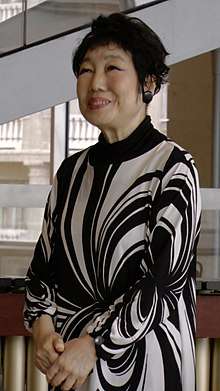Keiko Abe
Keiko Abe (安倍 圭子, Abe Keiko, born April 18, 1937) is a Japanese composer and marimba player. She has been a primary figure in the development of the marimba, in terms of expanding both technique and repertoire, and through her collaboration with the Yamaha Corporation, developed the modern five-octave concert marimba.
Keiko Abe 安倍 圭子 | |
|---|---|
 | |
| Background information | |
| Born | April 18, 1937 Tokyo, Japan |
| Instruments | Marimba |
| Website | keiko-abe |
Biography
Abe began playing the xylophone while in elementary school in Tokyo, Japan, studying under Eiichi Asabuki. At age 13, she won an NHK talent contest and began performing professionally on live radio. She attended Tokyo Gakugei University where she completed a bachelor's and master's degree in music education. She began working in the Nippon Columbia, NHK and other recording studios while in college.
In 1962, she and two friends (who were also students of Asabuki) founded the Xebec Marimba Trio, performing popular music, arrangements of folk songs and some of Abe's arrangements. They recorded more than seven albums between 1962 and 1966. During this period she had her own show on Japanese television, instructing schoolchildren in xylophone playing, as well as a radio show called "Good Morning Marimba". She also began her recording career, putting out 13 albums in a five-year span.
In 1963, the Yamaha Corporation sought Japanese marimba players to assist in the design of their new instruments; Keiko Abe was chosen for her original and clear ideas of the marimba sound and design, particularly her concept of how the marimba should be able to blend in ensembles, for example, moving away from the inconsistencies and lack of focus of folk percussion instruments. Her ideas for the desired sound of the instruments guided Yamaha's design, and in the 1970s began production. In addition, at her urging, the range of the new marimba was stretched from four octaves to five, which has become the standard for soloists. Abe has been closely associated with Yamaha ever since, and their first ever signature series of keyboard percussion mallets bears her name.
Her compositions, including "Michi", "Variations on Japanese Children's Songs", and "Dream of the Cherry Blossoms", have become standards of the marimba repertoire. Abe is active in promoting the development of literature for the marimba, not only by writing pieces herself, but also by commissioning works by other composers and encouraging young composers. She has added at least 70 compositions to the repertoire. She uses improvisation as an important element in developing her musical ideas which she then uses in her compositions.
In addition to her intensive composing, touring, and recording schedule, Abe has been a lecturer, then professor, at the Toho Gakuen School of Music in Tokyo since 1970. She was the first woman to be inducted into the Percussive Arts Society Hall of Fame in 1993.
Abe uses the YM-6100 Marimba made by Yamaha.
Her music is mainly published by Xebec Music Publishing and Schott, Japan.
References
- J. Michele Edwards. "Keiko Abe", Grove Music Online, ed. L. Macy (accessed February 14, 2006), grovemusic.com (subscription access).
- Rebecca Kite. "Keiko Abe, A Virtuosic Life: Her Musical Career and the Development of the Concert Marimba", published 2007, GP Percussion
- TRAPS Magazine interview, Spring 2007: